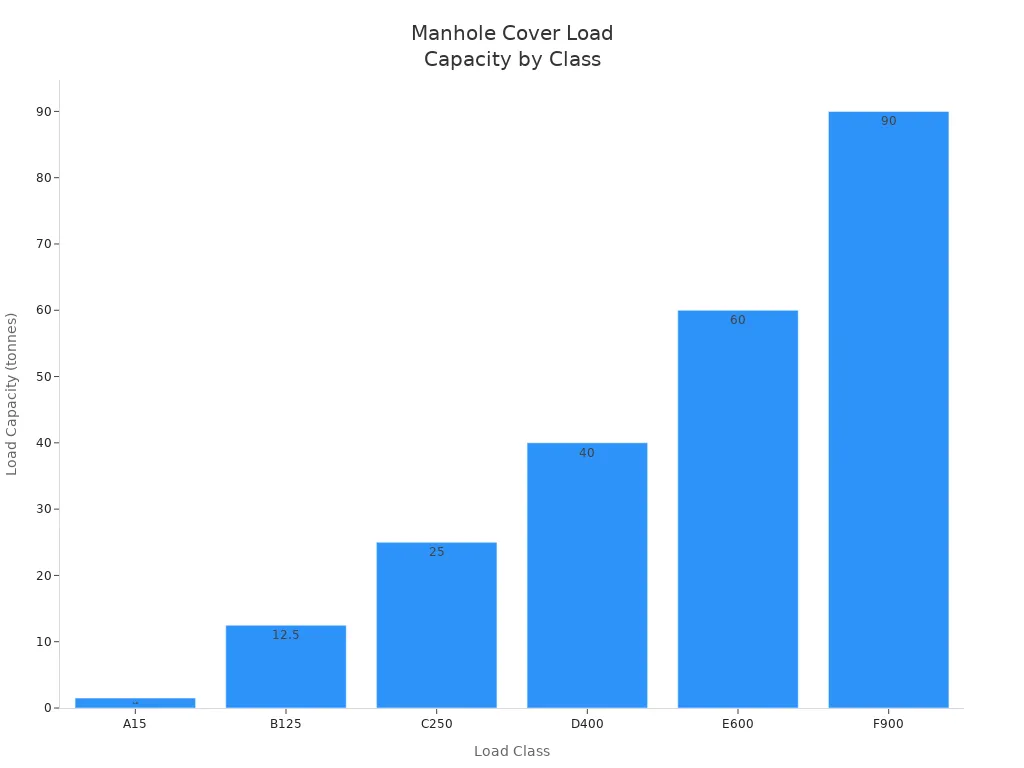Views: 0 Author: Site Editor Publish Time: 2025-08-08 Origin: Site











Every neighborhood needs small things to stay safe and clean. Manhole cover grating is very important for this. People see how it helps every day.
It stops accidents on sidewalks and roads.
It lowers flooding by letting water drain fast.
It keeps trash and leaves out of the drains.
It protects the neighborhood from people getting in who should not.
People who notice these things help make their community safer.
Manhole cover grating helps keep people and cars safe. It covers holes so no one falls in. This stops accidents on sidewalks and roads.
Grates let water drain fast when it rains. This lowers flooding and keeps homes and streets safe from water damage.
They stop trash and leaves from going into drains. This keeps the drainage system clear and the neighborhood clean.
Strong covers stop people from getting in without permission. They also stop theft. This keeps underground systems safe and streets secure.
Checking and cleaning manhole cover grating often helps keep things safe. It also stops problems in the community.
Manhole cover grating helps keep people safe on sidewalks and streets. Sometimes, manholes are open or broken. This can cause people to fall in and get hurt. Falls into deep holes can break bones or hurt heads. Some people may even become paralyzed. Many cities get lots of reports about missing or loose covers. If a cover is gone, anyone walking or riding a bike can get injured. Manhole cover grating stops these accidents by covering the holes.
Manufacturers use strong materials like cast iron, ductile iron, steel, and composites. These materials do not rust easily and last a long time. Some covers have special surfaces that help stop slips and falls. This helps when the ground is wet or icy. Safety grilles under the main cover give extra protection. They keep people from falling in during repairs or cleaning.
Tip: If you see a loose or missing manhole cover grating, tell your local authorities right away.
Manhole cover grating also keeps drivers and cyclists safe. If covers are open or loose, cars and bikes can get stuck or lose control. This can cause crashes, injuries, and cost a lot to fix. Trench grates on roads and parking lots stop vehicles from falling into holes. They also help water drain off the road. This lowers the chance of skidding when it is wet.
It is important to pick the right material and load rating for safety. The table below shows different load classes and where they are used:
| Load Class | Load Capacity | Typical Application |
|---|---|---|
| A15 | Up to 15 kN | Pedestrian areas |
| B125 | Up to 125 kN | Light vehicular traffic, residential roads |
| C250 | Up to 250 kN | Carriageways with medium traffic |
| D400 | Up to 400 kN | Roads, parking areas with cars and trucks |
| E600 | Up to 600 kN | Heavy goods vehicle zones, docks, loading areas |

Covers need to be installed the right way and checked often. If covers are overloaded, put in wrong, or rust, they can break or move. Using the right manhole cover grating for each place helps keep roads and paths safe for everyone.
Manhole cover grating helps keep streets dry when it rains a lot. Water goes through the grating and moves into pipes below. This stops water from building up on roads and sidewalks. If rainwater cannot drain, streets can flood fast. Flooded roads make it hard for cars and people to travel safely.
Many studies show how important clear grates are for drainage. Here are some results:
If grates are blocked, they drain 25% less water.
Steep roads can lower pipe drainage by almost 9%.
If outlets are underwater, drainage drops by over 23%.
Sensors in tests help measure water flow and runoff. This gives data to help cities improve drainage.
Good grate design and cleaning keep water moving and stop floods.
Note: Cleaning grates and removing trash is an easy way to help your neighborhood avoid floods.
Modern materials like FRP and ductile iron do not rust or break easily. These materials last for many years, even in wet weather. They are strong enough for heavy traffic and still let water pass through.
Manhole cover grating protects homes, stores, and public buildings from water damage. When water drains fast, it cannot get into basements or hurt foundations. Good drainage also keeps streets and sidewalks from washing away.
Cities use different load classes for grates in each area. The table below shows common classes and where they are used:
| Load Class | Load Capacity (tonnes) | Typical Application Areas |
|---|---|---|
| A15 | 1.5 | Gardens, walking paths |
| B125 | 12.5 | Driveways, light parking |
| C250 | 25 | Light traffic roads, private car parks |
| D400 | 40 | Main roads, highways, busy public car parks |
| E600 | 60 | Industrial areas, cargo yards |
| F900 | 90 | Airports, docks |

Cities pick the right size and strength for each place. This planning keeps drainage working, even during storms. Watertight covers can also stop water from coming back up into manholes. This protects important systems and lowers property damage.
Manhole cover grating helps keep drains clear in cities. It works like a barrier that stops trash, leaves, and other debris. Water from rain can go through the grating, but big things cannot. This keeps drains from getting blocked and stops water from flooding streets and sidewalks.
Studies show that grate-type inlets act like filters in storm sewers. They catch debris but let water pass through. The shape and size of the grates matter for blocking trash. If too much trash piles up, the grating can get clogged. This makes it hard for water to drain. Cleaning and good design help the system work well.
Tip: People can help by picking up trash and not sweeping leaves into the street. Clean grates mean less flooding and safer places to live.
Maintenance teams do many things to keep gratings working:
Check grates every few months for cracks or rust.
Take away dirt, leaves, and plastic after storms.
Put on anti-rust paint and repaint when needed.
Change broken covers right away.
Use strong covers in busy places.
Teach workers to use checklists for their jobs.
Manhole cover grating also helps stop pollution in city water. It blocks trash and chemicals from getting into rivers and lakes. Composite resin and FRP covers have extra good points. Making them uses less energy and makes less pollution than cast iron covers. These covers last longer, do not rust, and can be recycled. This means less waste and a smaller carbon footprint.
FRP covers need less care and make less waste.
Their waterproof design keeps pipes safe from harm.
Lighter covers mean less pollution from trucks.
Recyclable covers help save resources.
Good stormwater drainage keeps dirty water out of nature. This protects fish, plants, and people. Cleaner streets and water make neighborhoods nicer and healthier.
Manhole cover grating keeps people out of underground spaces if they do not have permission. Cities use strong materials like ductile iron and composite to make covers hard to move. These covers are heavy and can weigh up to 150 pounds. Most people cannot lift them without special tools. New designs have locks and bolt-down units to hold covers in place. Some covers have seals and rims that close tightly, so you need the right key to open them.
Many covers have safety features to help workers and keep others out. Hinged covers with safety stops help stop accidents when someone opens them. Pick holes let workers lift covers safely but do not make it easy to take them off. Some covers use high-security locks, like LPCB Level 3, and stainless steel locking systems. Only workers with permission can open these locks. Safety keyways keep lifting keys from slipping out by mistake. Cities test these features to make sure they work and meet rules like BS EN 124:2015.
Note: Secure manhole cover grating keeps important systems safe and stops people from getting hurt.
Common Security Features Table
| Security Feature | Purpose |
|---|---|
| Locks/Bolt-down Units | Prevent unauthorized access |
| Seals and Rims | Ensure tight closure |
| Hinged Covers | Reduce injury risk |
| Safety Stops | Prevent accidental closure |
| Pick Holes | Allow safe lifting |
| High-Security Locks | Limit access to authorized personnel |
Stealing manhole cover grating is a problem in many cities. Thieves take old cast iron covers to sell as scrap metal. This leaves holes in the street and puts people and cars in danger. Cities now use composite and polymer covers that are not worth money as scrap. These covers are lighter but still strong. Designers add anti-theft features to composite covers, like captive hinges and locking systems, to keep them safe.
Ductile iron covers are hard to steal because they are heavy and hard to move. Composite covers are lighter, so they need extra security features. Some covers use locks that only let one lock open at a time. This makes it harder for thieves to take the cover. Safety stops and link fasteners also help stop covers from falling in or being removed easily.
Tip: When cities pick manhole cover grating with theft deterrence, they save money and keep streets safer.
Neighborhoods are safer and cleaner with strong covers. These covers stop accidents and help prevent floods. They also block trash and make places more secure. Keeping covers tight and clean helps them last longer. It also keeps people safe. Public campaigns, like “The Sea Starts Here,” teach people to keep drains clean.
If someone sees a broken or missing cover, they should tell local authorities. Give the place, a picture, and a clear description. Acting fast helps keep everyone in the community safe.
Cities pick cast iron, ductile iron, steel, or composite for covers. These materials do not rust and last a long time. Composite covers are lighter and thieves do not want them. Each type works best in different places.
Workers need to check manhole cover grating every few months. After storms, they look for damage or things blocking the grates. Checking often helps stop accidents and keeps drains working.
Manhole cover grating helps water drain fast to lower flooding. It cannot stop every flood, especially in big storms. Clean and good grates work best to keep roads dry.
Locks and bolts stop people from getting into manholes. These parts protect important things under the ground. They also help stop theft and keep people safe.
People should tell local authorities if a cover is broken or gone. Giving the place and a picture helps workers fix it faster. Acting quickly keeps everyone safe.